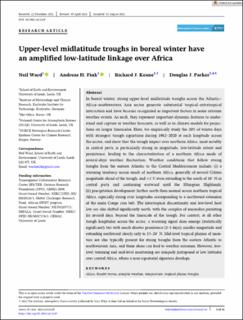| dc.contributor.author | Ward, Neil | |
| dc.contributor.author | Fink, Andreas H. | |
| dc.contributor.author | Keane, Richard J. | |
| dc.contributor.author | Parker, Douglas John | |
| dc.date.accessioned | 2023-09-20T07:43:10Z | |
| dc.date.available | 2023-09-20T07:43:10Z | |
| dc.date.created | 2022-09-30T10:29:37Z | |
| dc.date.issued | 2022 | |
| dc.identifier.citation | Atmospheric Science Letters. 2022, 24 (1), . | en_US |
| dc.identifier.issn | 1530-261X | |
| dc.identifier.uri | https://hdl.handle.net/11250/3090665 | |
| dc.description.abstract | In boreal winter, strong upper-level midlatitude troughs across the Atlantic–Africa–southwestern Asia sector generate substantial tropical–extratropical interaction and have become recognized as important factors in some extreme weather events. As such, they represent important dynamic features to understand and capture in weather forecasts, as well as in climate models for projections on longer timescales. Here, we empirically study the 20% of winter days with strongest trough signatures during 1982–2020 at each longitude across the sector, and show that the trough impact over northern Africa, most notably in central parts, is particularly strong in magnitude, low-latitude extent and persistence, leading to the characterization of a northern Africa mode of several-days weather fluctuation. Weather conditions that follow strong troughs from the eastern Atlantic to the Central Mediterranean include: (i) a warming tendency across much of northern Africa, generally of several Celsius magnitude ahead of the trough, and >1°C even extending to the south of 10° N in central parts and continuing eastward until the Ethiopian Highlands; (ii) precipitation development further north than normal across northern tropical Africa, especially strong over longitudes corresponding to a northward extension of the main Congo rain belt. The intertropical discontinuity and low-level heat low are also shifted significantly north, with the complex of anomalies persisting for several days, beyond the timescale of the trough. For context, at all other trough longitudes across the sector, a warming signal does emerge (statistically significant), but with much shorter persistence (2–3 days), smaller magnitude and extending southward clearly only to 15–20° N. Mid-level tropical plumes of moisture are also typically present for strong troughs from the eastern Atlantic to southwestern Asia, and these alone can lead to weather extremes. However, low-level warming and mid-level moistening are uniquely juxtaposed at low latitudes over central Africa, where a near-equatorial signature develops. | en_US |
| dc.language.iso | eng | en_US |
| dc.rights | Navngivelse 4.0 Internasjonal | * |
| dc.rights.uri | http://creativecommons.org/licenses/by/4.0/deed.no | * |
| dc.title | Upper-level midlatitude troughs in boreal winter have an amplified low-latitude linkage over Africa | en_US |
| dc.title.alternative | Upper-level midlatitude troughs in boreal winter have an amplified low-latitude linkage over Africa | en_US |
| dc.type | Peer reviewed | en_US |
| dc.type | Journal article | en_US |
| dc.rights.holder | © 2022 The Authors | en_US |
| dc.description.version | publishedVersion | en_US |
| cristin.ispublished | true | |
| cristin.fulltext | original | |
| cristin.qualitycode | 1 | |
| dc.identifier.doi | 10.1002/asl.1129 | |
| dc.identifier.cristin | 2057070 | |
| dc.source.journal | Atmospheric Science Letters | en_US |
| dc.source.volume | 24 | en_US |
| dc.source.issue | 1 | en_US |
| dc.source.pagenumber | 13 | en_US |
| dc.relation.project | Andre: Global Challenges Research Fund NE/P021077/1 | en_US |
| dc.relation.project | Andre: IMPALA: NERC/DFID NE/M017176/1 | en_US |
| dc.relation.project | Deutsche Forschungsgemeinschaft: NERC/DFID_NE/M020126/1 | en_US |

